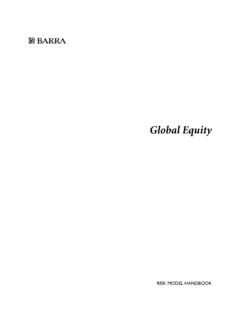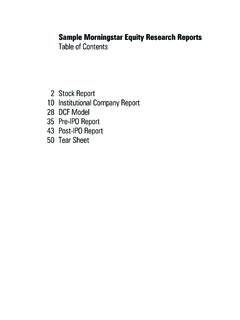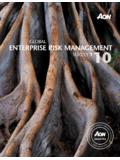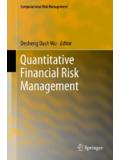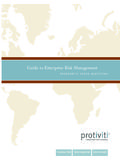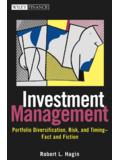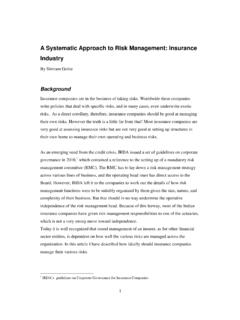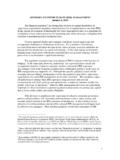Transcription of United States Equity - Information & Workflow Solutions
1 United States Equity Version 3 (E3). RISK MODEL HANDBOOK. BARRA makes no warranty, express or implied, regarding the United States Equity Risk Model or any results to be obtained from the use of the United States Equity Risk Model. BARRA EXPRESSLY DISCLAIMS ALL WARRANTIES, EXPRESS OR IMPLIED, REGARDING THE United States Equity RISK MODEL, INCLUDING BUT NOT LIMITED TO ALL IMPLIED WARRANTIES. OF MERCHANTABILITY AND FITNESS FOR A PARTICULAR PURPOSE OR USE OR THEIR EQUIVALENTS UNDER THE. LAWS OF ANY JURISDICTION. Although BARRA intends to obtain Information and data from sources it considers to be reasonably reliable, the accuracy and completeness of such Information and data are not guaranteed and BARRA will not be subject to liability for any errors or omissions therein.
2 Accordingly, such Information and data, the United States Equity Risk Model, and their output are not warranted to be free from error. BARRA does not warrant that the United States Equity Risk Model will be free from unauthorized hidden programs introduced into the United States Equity Risk Model without BARRA's knowledge. Copyright BARRA, Inc. 1998. All rights reserved. 0111 O 02/98. Contents About BARRA .. 1. A pioneer in risk management .. 1. Introduction .. 3. In this handbook.. 3. Further references .. 5. Books .. 5. Section I: Theory 1. Why Risk is Important .. 7. The goal of risk analysis.. 8. 2. Defining Risk .. 11. Some basic definitions ..11. Risk measurement .. 13. An example .. 13.
3 Risk reduction through diversification .. 14. Drawbacks of simple risk calculations .. 16. Evolution of concepts .. 16. 3. Modeling and Forecasting Risk .. 21. What are MFMs? .. 21. How do MFMs work? .. 21. Advantages of MFMs .. 22. A simple MFM .. 23. Model mathematics .. 25. Risk prediction with MFMs .. 26. i 4. Modern Portfolio management and Risk .. 31. Portfolio management two types .. 31. Passive management .. 31. Active management .. 32. Decomposing risk.. 34. Total Risk .. 34. Systematic-Residual Risk Decomposition .. 35. Active Risk Decomposition .. 36. Active Systematic-Active Residual Risk Decomposition .. 37. Summary of risk decomposition .. 38. Performance attribution .. 38. Summary.
4 39. 5. BARRA Multiple-Factor Modeling .. 41. Overview .. 41. Descriptor selection and testing.. 44. Descriptor standardization .. 44. Risk index formulation .. 45. Industry allocation .. 45. Factor return estimation .. 46. Covariance matrix calculation .. 46. Exponential weighting .. 47. Computing market volatility: Extended GARCH models.. 48. Specific risk modeling .. 49. Overview .. 49. Methodology .. 50. Modeling the average level of specific risk .. 50. Modeling the relative level of specific risk .. 51. Estimating the scaling coefficients .. 52. Final specific risk forecast.. 52. Updating the model .. 52. Comparison of risk model features .. 53. ii Equity Model Version 3 (E3). Section II: US-E3 Model Details 6.
5 Advantages of US-E3 Over US-E2 .. 55. Overview .. 55. Industries .. 56. Reclassification .. 56. Flexible industries .. 57. Increased size of the estimation universe .. 57. Risk indices .. 58. Size Nonlinearity factor .. 58. Leverage .. 58. Simpler volatility calculation .. 58. Elimination of US-E2's Labor Intensity and Foreign Income .. 59. Improved independence between risk indices .. 59. Risk forecasting.. 59. Improved GARCH model .. 59. Specific risk model.. 60. Model fit-related issues .. 60. Factor return estimation .. 60. Ongoing diagnostics .. 60. Scheduled refitting of model parameters .. 60. Asset class issues.. 61. REITs .. 61. Coming soon .. 61. 7. The US-E3 Estimation Universe.
6 63. Overview .. 63. Selection process .. 63. 1. S&P 500 membership .. 64. 2. Compustat data present .. 64. 3. Capitalization.. 64. 4. Minimum price .. 64. 5. Industry fill-in .. 64. 6. Grandfathering.. 65. Comparison with the US-E2 estimation universe .. 65. Contents iii 8. US-E3 Risk Indices and Descriptors .. 67. Differences between US-E2 and US-E3 risk indices.. 67. General differences .. 67. Specific differences .. 67. Volatility.. 67. Size .. 68. Size Nonlinearity (US-E3).. 68. Growth .. 68. Financial Leverage (US-E2) and Leverage (US-E3) .. 69. Foreign Income (US-E2) and Currency Sensitivity (US-E3) .. 69. Labor Intensity (US-E2) .. 69. US-E3 and US-E2 risk indices at a glance .. 70. Risk index definitions.
7 74. 1. Volatility .. 74. 2. Momentum.. 74. 3. Size .. 74. 4. Size Nonlinearity .. 74. 5. Trading Activity.. 74. 6. Growth .. 75. 7. Earnings Yield .. 75. 8. Value .. 75. 9. Earnings Variability .. 75. 10. Leverage .. 75. 11. Currency Sensitivity .. 75. 12. Dividend Yield.. 75. 13. Non-Estimation Universe Indicator .. 76. Descriptor definitions .. 76. 9. US-E3 Industries .. 77. Overview .. 77. Industry classification scheme .. 77. Mini-industries and industries.. 77. Sectors .. 78. Industry weights .. 79. 1. The valuation models .. 79. 2. Asset industry weights for each model .. 79. iv Equity Model Version 3 (E3). 3. Final weights .. 80. Historical assignment of industry and weights .. 80. Ongoing assignment of industry and weights.
8 80. Industry evolution .. 81. Sector mapping of US-E3 industries .. 82. 10. Factor Return Estimation .. 85. Overview .. 85. Estimation details .. 85. GLS weights .. 86. Factor returns for historic newborn industries .. 86. The NONESTU factor return .. 86. Testing .. 87. 11. Estimating the Factor Covariance Matrix in US-E3 .. 89. Overview .. 89. 12. US-E3 Specific Risk Modeling .. 91. Overview .. 91. Appendix A: US-E3 Descriptor Definitions .. 93. 1. Volatility .. 93. 2. Momentum.. 95. 3. Size .. 96. 4. Size Nonlinearity .. 96. 5. Trading Activity.. 96. 6. Growth .. 98. 7. Earnings Yield .. 100. 8. Value .. 101. 9. Earnings Variability .. 101. 10. Leverage .. 102. 11. Currency Sensitivity.
9 103. 12. Dividend Yield.. 104. 13. Non-Estimation Universe Indicator .. 104. Contents v Appendix B: US-E3 Industries, Mini-Industries, Example Companies, and Codes .. 105. Appendix C: US-E3 Frequency Distributions for Predicted Beta, Specific Risk, Risk Indices .. 115. Predicted beta.. 115. Specific risk .. 115. Risk indices .. 116. Appendix D: US-E3 Risk Index Factor Returns .. 121. Glossary .. 127. Index .. 137. Contributors .. 143. vi Equity Model Version 3 (E3). About BARRA. In recent years the investment management industry has adjusted to continuing changes theoretical advances, technological develop- ments, and market growth. To address these challenges, investment managers and financial institutions require the most advanced and powerful analytical tools available.
10 A pioneer in risk management As the leading provider of global investment decision tools, BARRA. has responded to these industry changes by providing quantitative products and services that are both flexible and efficient. Since our founding in 1975, BARRA has been a leader in modern financial research and techniques. Initially, our services focused on risk analysis in Equity markets. Our Equity Model set a standard of accuracy that BARRA continues to follow. BARRA uses the best data available to develop economet- ric financial models. In turn, these models are the basis of software products designed to enhance portfolio performance through returns forecasting, risk analysis, portfolio construction, transaction cost analysis, and historical performance attribution.
